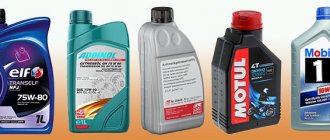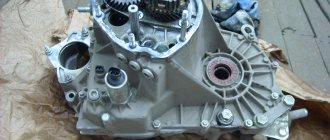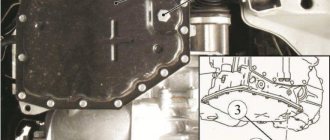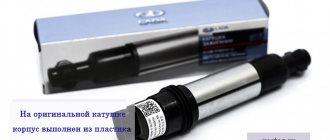VAZ is an engineering plant, the history of which has already crossed the fifty-year mark from the production of the first car. Over the many years of its activity, VAZ has undergone modernization several times, and this has helped it even today to compete adequately with foreign automakers. And if an old “kopek” or “six” can most often be found in small cities and towns, then cars of new years of production successfully compete with “foreign cars” on the roads of megacities.
Recommendations for choosing engine oil for VAZ.
The significant advantages of a domestic car are its affordable price range and maintainability, which allows you to easily service the car at home. The long service life of the cars is another huge plus for the automaker, and the wear resistance of the car is guaranteed by proper and timely care of the owner for his vehicle. In this article we will talk about one of the most important areas of car care - changing the oil in the power unit, namely, the correct choice of engine oil and the importance of this point for the functioning of vehicles. Let's consider what kind of oil to pour into a VAZ engine, how to choose the right lubricant for your car in order to ensure a long period of operation and be confident in the reliability and uninterrupted operation of the engine.
The main criteria for choosing a motor oil
Choosing the most suitable engine fluid is a difficult task not only for owners of domestically produced cars, but also for any consumer. The task is complicated by the huge range of lubricants on the market and their technological characteristics, which may be perfectly suitable for one model of machine and be strictly contraindicated for another.
When choosing oil for a VAZ, it is important to follow the instructions from the car manufacturer, taking into account the following criteria, which can significantly affect the choice:
- vehicle model, taking into account its year of manufacture and engine modification;
- wear and tear of the power unit, which is determined by the mileage traveled by the car, driving style and the degree of load on it;
- climatic operating conditions.
These factors, taking into account the manufacturer’s regulations, determine the final choice of motor fluid. Let's consider how to make the correct and rational selection of a lubricating emulsion for the engine of your vehicle.
Correct selection of lubricants
First of all, before making a selection, it is important to decide what type of lubricant is best for your car. Engine lubricants are provided to the consumer in three categories: synthetic, mineral and semi-synthetic.
It is generally accepted that synthetic oil is an example of quality that is suitable for any engine and will cope with its functional tasks as well as possible. And indeed this is almost always the case when it comes to modern engines of new modifications. In situations where a car oil is selected for a worn-out engine, or the manufacturer recommends the use of a mineral or semi-synthetic lubricant from the factory, synthetics may not only fail to fulfill their tasks, but also significantly affect the functionality and operational period of the power unit in the direction of worsening the criteria. Old VAZ models that came off the assembly line before 1990 are equipped with rubber sealing components that are exposed to synthetic ingredients and subject to deformation, which will negatively affect the performance of the engine.
For new vehicle models, synthetics are indeed recommended, however, again, you should be guided solely by the regulations. If the manufacturer advises using only semi-synthetic lubricant for a specific car model, then purchasing synthetics in this case will simply be throwing money away. In addition, according to the advice of professionals, switching to mineral lubricants will be justified if the car has a mileage of more than two hundred thousand kilometers. When selecting a car oil, you should additionally focus on the price criteria of the lubricant: the engine of even old Zhiguli cars will react negatively to low-quality cheap lubricant. Preference should be given to oils of the middle category in terms of price. In the user manual, the manufacturer always indicates the recommended engine oil quality standards, as well as the names of motor oils that are approved for use in a specific car model.
And then the most interesting thing: to understand the markings and not everyone understands the specifications that are indicated on the labels of the products offered, and for owners of old cars to also choose an alternative option from the modern assortment, taking into account the technological data of lubricants, since if the car is out of production, find a “original” » lubricating the motor is almost impossible.
Marking features
In searching for an answer to the question of which oil is best to pour into the engine, you need to learn how to navigate the standardization of motor oils according to the SAE viscosity coefficient and API class. Cars from domestic automakers are no exception in this regard. For convenience, we will divide VAZ vehicles into two categories: those produced before and after 2000.
The first category of cars, produced before 2000, is mainly models from “kopek” to “seven”, as well as the VAZ-2121 family of cars, modified with carburetor-type units. Motor oils for these machines must comply with the API product category marked SF, which regulates their intended use for engines running on gasoline with a low ethyl ratio and operating under severe operating conditions. These are mainly mineral-based lubricants, which have proven themselves when used in engines with significant wear. SF class motor oils are distinguished by high anti-wear and anti-corrosion properties, protect the unit from deposits without corroding structural sealing parts.
The second group of VAZ cars are cars that came off the assembly line after 2000, including the new Vesta and XRAY models from VAZ. The power units of these vehicles, regardless of the year of production, require a lubricant that belongs to the “Standard” category, meets the API product group SG for high-speed gasoline systems, or products of the SJ rank used in modern gasoline engines. These are mainly motor oils of the synthetic and semi-synthetic class, characterized by a longer service life and improved anti-wear criteria.
Having decided on the API class of lubricant suitable for your car’s engine, you can begin to decide which oil to choose based on the viscosity criterion. This parameter on the packaging of manufactured products is marked with an SAE value, registered in the form of two codes separated by a hyphen. The first part of the code is a number with the symbol W, which indicates the viscosity of the product at sub-zero temperatures. The lower this number, the more viscous the oil is, which requires choosing a product with a minimum value in the harsh climatic conditions of using the machine. The second part of the code is a value that determines the functionality of the product under load conditions, and, accordingly, at elevated temperature conditions.
In addition, oils are divided into types depending on seasonal use: summer, winter and all-season. It is more practical to select oils for VAZs that have been discontinued or have decent mileage from the category of all-season products, distinguished by the SAE J300 index found on the product label. For regions with a slight temperature difference, as well as when the machine is operated with minimal load on the engine, lubricants with a coefficient of 5W40 are perfect. If the engine is regularly subjected to workloads, then a more rational option would be to fill with oil with a higher second coefficient, for example, 5W50.
For new cars, as well as cars with low mileage, the oil options recommended by the VAZ manufacturer are considered exclusively seasonal lubricants. For winter, the automaker recommends using motor oil whose viscosity varies from 0 to 10, depending on the severity of the climate in your region. At the same time, you should not take it with a reserve, for example, at an average temperature outside of minus ten degrees, the use of 0W-40 motor oil is inappropriate not only from an economic point of view, but also for reasons of usefulness for the engine. In such a situation, it is better to use 10W-40 oil for the engine; as an exception, it is permissible to use a lubricant with a viscosity parameter of 5W-40.
Classification of engine oils
The VAZ 2107 manufacturer does not regulate the type of motor fluid in the vehicle’s operating instructions. If it meets the tolerances and quality, then any type can be used: mineral, synthetic or semi-synthetic lubricant.
On canisters of motor oil, markings such as API SJ, API SG/GD are most often indicated, demonstrating the quality of the product
When choosing motor lubricant for the seven, special attention should be paid to these designations
The abbreviation API stands for American Petroleum Institute, which translated into Russian means “American Petroleum Institute”. The non-governmental organization deals with issues of the oil industry. One of the areas of the API Institute is the development of norms and standards for the petroleum products and gas industry.
Motor oil is standardized according to the following characteristics:
- toxicity;
- corrosive effects;
- cleaning properties;
- protection of mechanisms from friction and wear;
- temperature indicators;
- the amount of deposits forming on the surface of the internal combustion engine system mechanisms.
For the VAZ 2107 model, motor fluid corresponding to the abbreviation API SG/GD is suitable.
On a note! Motor oils according to SAE standards marked 5w40 indicate only the viscosity index. In this case, the classification does not take into account the quality, characteristics and properties of the lubricant product.
The amount of oil in VAZ engines
Having understood the markings and decided on the type and brand of motor oil needed to fill the unit, before purchasing the product, it is important to know how much oil is in the VAZ engine in order to understand what container capacity should be purchased. Of course, you can also change the fluid at a service station, where service workers will recommend the type of oil and perform engine maintenance themselves. But, as practice shows, the excellent maintainability of a car is increasingly helping to independently replace lubricants, and accordingly creates the need for knowledge on the required fluid volume for the engine of your car.
The exact volume of oil in a VAZ engine varies depending on the modification of the engine itself installed on the car. Every car owner can view this information in the vehicle owner's manual. Older cars are modified with engines with a displacement of 3.75 liters of motor oil. Modern VAZ models are equipped with units with a lubricant volume of 3.5 to 4 liters, with the exception of models 21126 and 21129, which will require about 4.5 liters of emulsion for replacement. When purchasing lubricating fluid, it is worth purchasing it with a small reserve, rounding the volume of the unit up to a whole number. The remainder in this case will act as a reserve in case of need to top up the oil.
Great owner review
The owner of a Lada Vesta (gagarinec) decided to find out which oil for the VAZ 21807 manual transmission is better to choose.
During the operation of his car, he changed the oil in the transmission several times, each time filling in a new brand of oil. Here are his observations:
- Oil ROSNEFT Kinetic MT 75W85 GL-4. This is the factory option. Nothing drastic happened, except for updating the gearbox oil.
- Castrol Syntrans Multivehicle 75W90 GL-4. I expected improvements in work, but nothing much has changed.
- UAZ 75W85 GL-4 (LUKOIL). It seemed that it was getting better, but time passed and it became clear that, if there were any improvements, they were at the placebo level.
- Castrol Syntrans Transaxle (Castrol Transmax Manual Transaxle) 75w90 GL-4+ (15d705), I liked the option with this oil the most. Shifts became somehow “oilier”, i.e. not dry, with steps and bumps, as if there was water in the gearbox, but soft, as it should be in a normal gearbox.
As a result, he settled on the latter option. What gear oil can you recommend?
Source
Let's sum it up
Domestic VAZ cars, no less than foreign ones, need proper and high-quality care to extend their performance characteristics. When choosing engine oil for your car, it is important to first of all follow the recommendations of the car manufacturer and choose the best option according to the stated requirements. In this case, be sure to take into account the climatic conditions in which the car will be operated and the degree of load on the power unit: depending on these criteria, the viscosity coefficient of the products required for the engine varies. Do not skimp on car oil, regardless of the condition, whether you are the owner of an old “penny” or a new Vesta - this can result in serious problems with the engine. Make replacements in a timely manner, and your car will serve you reliably for many years.
CONCLUSION
For myself, I have decided and use LUKOIL Lux, in winter - 5w30 and in summer 10w40. I always buy at the gas station with discounts and protection against counterfeiting. According to some reports, oil, like vodka, is poured into cans from one barrel.
In order to avoid problems starting the engine in winter, when purchasing lubricant, you need to follow several rules and use a reliable manufacturer: Castrol, Shell, ZIC, Mobil, Lukoil. Comply with the labeling and climatic conditions of your place of residence. Do not buy very cheap lubricant, chances are high that it is a fake. Japanese oils have also become popular. The assortment is wide, there are several dozen suitable options. Don't choose oil for winter work based on cost alone.











